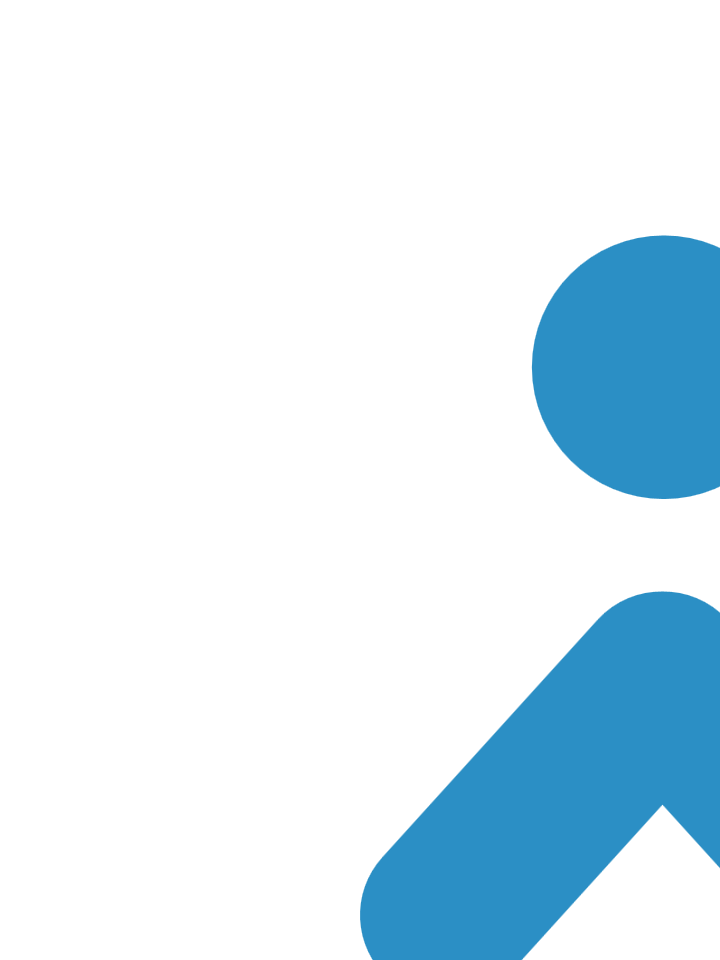Abstract
As organizations expand investment in artificial intelligence (AI), success depends not only on technology but also on human originality: Original Intelligence (OI). A focus on efficiency alone cannot sustain differentiation in the age of AI. OI is the ability to expand an idea space beyond the algorithmic prediction of AI. It defines the next frontier of competitive advantage.
The use of assessment devices to identify human performance is proven. There are existing measurements of creativity, empathy, leadership and other personal attributes that have been predictive of organizational development and human resource management. However, these tools are of lesser value when faced with AI adoption in an enterprise. This is due to two primary limitations. First, they are based upon fixed rubrics or methodologies that can be “gamed” by a person who uses AI tools to find the “right answer.” Second, they cannot measure the metric most important to AI adoption in the enterprise: how will a person use AI to create business differentiation, or Original Intelligence.
This is why many current AI transformation efforts are not generating measurable positive changes. Without the tools to effectively target, train and manage AI and human co-collaboration and acceleration, leaders and managers are quite literally shooting in the dark. They confuse early adoption by the few with a pathway to adoption by many and are unable to target or match AI competency to AI deployments.
This is why Hupside’s Hupchecker product is so important to AI adoption. The Hupchecker is a SAS product that provides the first objective measurement of AI readiness on an individual basis: OI. Use of the Hupchecker provides insight into who will use AI as an accelerant and enhancement in their individual role performance, and where to target training and development.
The Hupchecker product is derived from the Hupside framework, a systematic and measurable process for identifying AI readiness and aligning an organization to capture the value of OI. We start by measuring OI. This begins with the Original Intelligence Quotient (OIQ) and OIQ Types, which identify the ability someone has to create something truly novel. From there, we determine Individual Autonomy across an organization with four additional supporting metrics—Originality Potential (OP), Originality Autonomy (OA), Personal Originality Value Intensity (POVI), and Role Originality Value Intensity (ROVI) – which together provide a picture of how to maximize originality potential per role. Together they form the first end-to-end system for linking human (and AI-enhanced) creative capability to measurable transformation outcomes. Return on investment can be tracked and measured for the first time because the outcome of successful AI adoption—acceleration of both efficiency and differentiation—can be tracked on an individual and aggregate basis.
________________________________________
The Hupside Framework
As organizations navigate the complexities of AI transformation, competitive advantage increasingly depends on the interplay between technological efficiency and human originality. While AI excels at automation and optimization, it inherently homogenizes output, narrowing the idea space and leading to sameness in output. To sustain differentiation, organizations must cultivate and measure human Original Intelligence (OI): the capacity to generate distinct, high-value ideas beyond AI's probabilistic boundaries.
Original Intelligence is the differentiating variable in AI transformation. Generative systems create efficiency; humans create distinction. By introducing measurable originality metrics, Hupside enables organizations to identify, develop, and deploy the people who deliver value beyond AI and make AI transformation more successful. The Hupchecker is the only existing software product that can objectively identify Original Intelligence after AI deployment.
Hupside’s baseline measurement output measures the absolute existence of an individual’s capability for Original Intelligence, whether or not the individual uses AI tools to manifest it. It measures against other human output and also against the output of market leading LLMs. This measurement, the Original Intelligence Quotient (OIQ), provides an objective determination of the intensity of an individual’s capacity for OI both on their own, and using AI. It also surfaces those that are currently not using AI as an accelerant to their OI and using it as a substitute.
OIQ is further refined by the categorization of each individual’s OI into one of ten distinct personal styles (OIQ Types) that predict how they will apply AI to enhance their Original Intelligence and how quickly an individual will adopt to using AI in this way. OIQ and OIQ Types provide insights that allow organizations to customize AI training and create teams based upon individual OI capability.
In an organization, an individual’s capacity for OI does not exist in a vacuum. Organizational roles and levels of autonomy will affect each individual’s ability to use their Original Intelligence to create business differentiation. Therefore, the Hupside framework also measures the individual’s level of autonomy within the organization in their current role. Four additional metrics—Originality Potential (OP), Originality Autonomy (OA), Personal Originality Value Intensity (POVI), and Role Originality Value Intensity (ROVI)— provide additional clarity on how a specific individual’s role in the organization enhances or encumbers the optimal use of their Original Intelligence. These additional metrics allow for a higher level of organizational assessment—matching individual OI capabilities to the role and identifying opportunities for OI improvement through organizational changes.
The Hupside framework transforms originality from an abstract concept into a quantifiable management tool. It enables leaders to identify where originality contributes most to value creation, and to align AI transformation with human innovation.
________________________________________
Original Intelligence as a Strategic Variable
In AI enabled enterprise, the technology value stack includes four components: data, infrastructure, AI systems, and Original Intelligence. As AI dominates the first three layers, OI is the defining source of differentiation. Where efficiency becomes ubiquitous—the spoken promise of AI—few organizations will succeed by competing on efficiency alone. Differentiation through OI is becoming more and more important.
Figure 1: Technology Value Stack
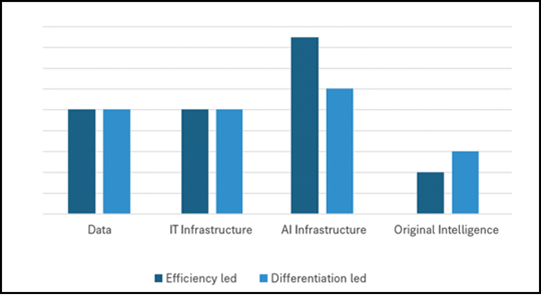
The mix between the four components will vary by the business model and strategy of an organization. For example, the use of AI agents will, if successfully deployed, result in a higher value add portion being derived from AI systems spend, and likely a lesser focus on Original Intelligence. Conversely, a business model that relies upon expert insight will incorporate a higher level of Original Intelligence in its technology value chain to provide for differentiation.
Due to the inherent limitations of AI, Original Intelligence will always be required in the portion of a business model that requires real differentiation. This is why OI is always part of the value stack in a post-AI organization, and most organizations don’t know it. What will differ is the degree and style in which each individual’s OI capabilities match their role. This means that effectively matching the individual’s capability for Original Intelligence to their role becomes more important, not less, post AI deployment. It also means that organizational units will need to optimize the relationship of OI and AI to maximize return on investment. When organizations systematically measure originality capability using the Hupside framework, they can design teams and workflows that amplify human creativity and encourage effective utilization of AI’s efficiency benefits to ensure that AI augments rather than replaces OI.
The Hupside Framework Metrics Explained
OIQ
Original Intelligence Quotient (OIQ) is a score that indicates an individual’s ability to generate ideas that fall outside AI’s statistical norm. High-OIQ individuals expand conceptual boundaries; lower-OIQ individuals align more closely with AI-derived results. OIQ is the first step in the Hupside framework and the input for all subsequent metrics.
The OIQ provides an objective measurement of how an individual will use OI when AI is available to them. This is done by objectively measuring their output for originality and comparing it to other humans and the output of prevailing LLMs. An individual who is naturally gifted, or who uses AI as an adjunct to accelerate their OI, will demonstrate a higher predilection for expanding an idea space and providing distinctiveness. While someone who uses AI verbatim will not. The OIQ is the measurement of an individual’s current OI capability.
OIQ Types
Using OIQ scores, we can get to a level of specificity to allow for more effective team building, training and job matching in a post AI environment. This occurs by identifying how an individual demonstrates OI through a distinct cognitive pattern—an OIQ Type. Hupside identifies 10 distinctive human patterns for applying OI in their role performance. The four primary OIQ Types are provided below (Figure 2).
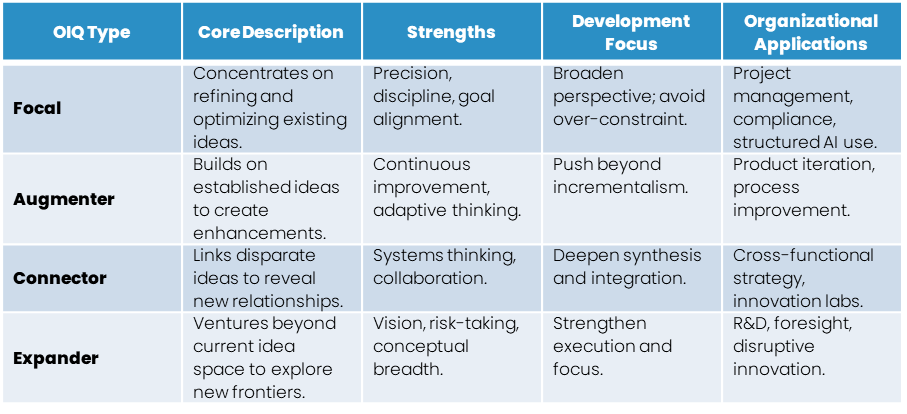
Why OIQ Matters
OIQ and OIQ types together set up a baseline that predicts individual adaptability to using AI and applying it under AI-assisted conditions. Areas of application include:
• Where to target AI-readiness training.
• Identification of innovation leaders and laggards.
• Risk assessment of individual adoption of AI.
Individual Autonomy – Looking at Organizational Role Through ROVI
When deploying AI in an organization, the application of an individual’s capacity for OI requires an additional measurement. This is the specific individual's level of autonomy to exercise OI in their current role within the organization. The more autonomy an individual has to create new ideas within their role, the more likely their OI will emerge and create differentiation. Looking at individual autonomy allows for management to identify where they might have a mismatch in OI and autonomy to exercise OI.
Originality Potential
Originality Potential (OP) ranks the level of autonomy an individual has in a role, by categorizing them in a continuum of individual role responsibility. In general, someone who works on their own without supervision has a higher degree of autonomy than someone who works in a group, and a senior leader has more ability to influence an organization than an entry level team member. This provides a baseline for the expected autonomy of an individual based on their role.
Originality Autonomy
Originality Autonomy (OA) recognizes that organizations can differ in the level of autonomy assigned to a role — for instance, there are undoubtedly CEOs with less autonomy than an engineering lead in some organizations, and places where a help desk manager can have greater discretion than a sales manager. OA allows for the organization’s cultural approach to autonomy to emerge. OA surfaces unique situations within an organization that differ from expected constraints, and when used together with OP provides a meaningful measurement of an individual’s autonomy within their current role. As an example, a high OA with low OP suggests an over-constrained environment, low OA with high OP signals leadership disengagement.
Figure 3. Originality Autonomy Survey Distribution Example

Personal Originality Value Intensity
Personal Originality Value Intensity (POVI) aggregates the OP and OA to identify the overall level of autonomy each individual has in their role. It is the degree to which an organization enables or limits the exercise of OI. POVI reflects structural design and autonomy simultaneously. A higher POVI shows fewer constraints and greater OI potential.
Figure 4. The POVI Matrix: Mapping Opportunity vs. Constraint
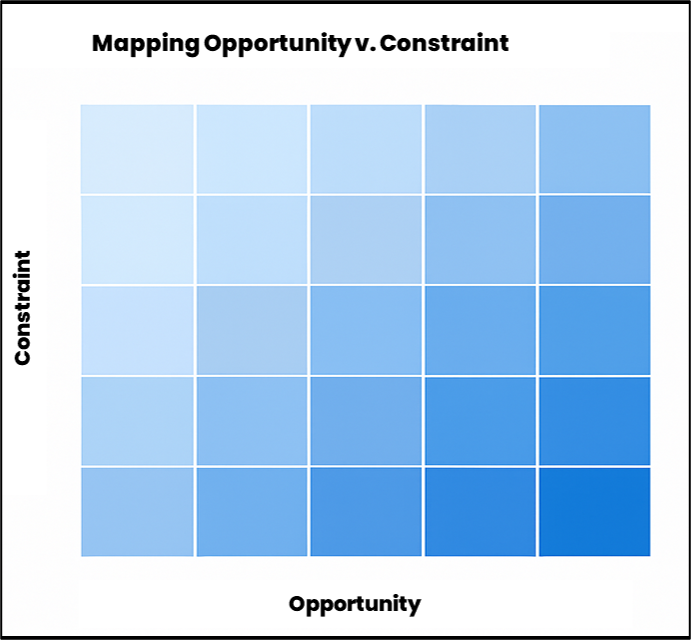
Role Originality Value Intensity
ROVI completes the picture by combining an individual’s OIQ with their POVI to identify the overall OI performance potential of a person in the specific role they occupy. ROVI provides the metric to predict how effectively OI will be operationalized by that specific person. And in the context of an AI deployment, how the organization will obtain positive benefits from the use of AI by that person.
Figure 5. OIQ/ROVI Diagnostic Quadrant

Diagnostic and Organizational Applications
The Hupside framework enables quantitative diagnosis of OI within organizational systems. It can clarify which types of people thrive in specific environments—Expanders in R&D, Connectors in transformation teams, Focals in quality control—making diagnostic mapping more actionable. It can also clarify where there are mismatches in organizational design or culture that are creating bottlenecks or limitations on using AI and humans to create differentiation. The framework is intended to provide the basis of many organizational challenges where understanding the human role in AI deployment and use will be essential. Some examples include:
• Identifying role mismatches: Detecting when structure limits creativity.
• Mapping originality hotspots: Targeting AI investment and innovation teams.
• Guiding training investments: Focusing resources where originality can scale.
• Measuring cultural evolution: Tracking OA and POVI across departments.
• Quantifying ROI on AI adoption: Link originality metrics to innovation and profitability.
Some Recommended Application of OIQ and ROVI into Change Management and AI Transformation
Measuring Readiness and Identifying Resistance
Baseline OIQ, OIQ types and ROVI data to establish an AI Readiness Index for each business unit or the organization as a whole. Surface individual attributes to predict readiness. For example:
• High OIQ (Expanders and Connectors) with high ROVI: individuals more likely to be natural early adopters, but also potentially requiring oversight and AI governance constraints.
• High OIQ (Expanders and Connectors) with low ROVI: individuals likely to be frustrated by AI adoption mandates without opportunity to innovate.
• Lower OIQ (Connectors, Augmenters and Focals) with high ROVI: individuals likely to be frustrated to a great or lesser extent by AI adoption mandates without specific training on AI within defined constraints.
• Low OIQ (Focals and Augmenters) with low ROVI: individuals most likely to resist or underperform without autonomy interventions or specific training based upon their role.
Figure 6. Measuring Readiness and Identifying Resistance
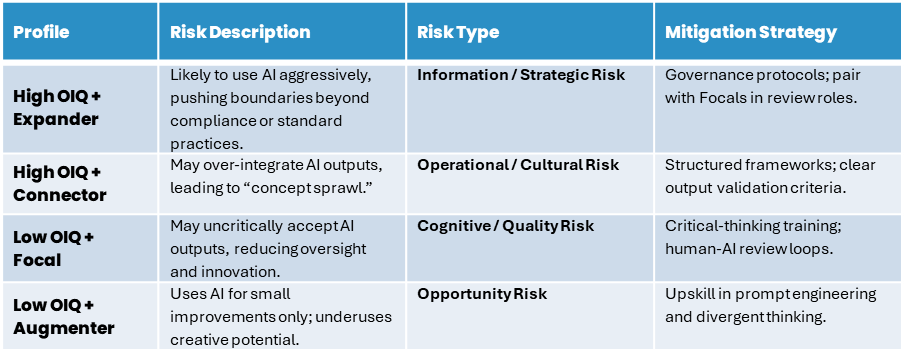
Targeting Interventions
ROVI also provides precision training diagnostics. For example:
• Low OIQ / High ROVI: Creative and AI-literacy training.
• High OIQ / Low ROVI: Leadership or workflow redesign.
• High OIQ / High ROVI: Leverage as transformation ambassadors.
Figure 7. Targeting Interventions

Culture Change
The Hupchecker and the Hupside framework allow leadership to engage individuals in a shared exercise of transformation. There is no “wrong answer” to an assessment of individual OI—it is an essential part of human behavior—it differs only in how it is exercised by the individual. Moreover, the message that AI is best used as an adjunct to individual originality not as a substitute allows for the adoption of AI to move from an “either/or” conversation to an “and” conversation. Allowing individuals to participate in the assessment and provide feedback on their perceptions of their autonomy further reinforces a sense of participation and individual empowerment. This can mitigate internal resistance to AI adoption that is currently framed by a fear of obsolescence. Hupside reframes the discussion: data proves where OI creates distinctiveness, and application of its results allows for roles and individuals to match and to maximize the benefits of AI.
AI delivers scale. Humans deliver distinction. ROVI ensures efficiency gains don’t come at the cost of creativity, making hybrid intelligence the foundation for sustainable transformation.
Sustaining AI Transformation Impact
Because there are proven cognitive risks to overreliance on AI, and also because the capabilities of AI continue to increase, continued measurement of OIQ and ROVI will allow an organization to keep pace. Some recommended metrics include ongoing measurement of:
• Improvement in ROVI and OIQ scores.
• Higher ROVI correlation with innovation KPIs
• Reduced homogenization in AI-assisted output reflected in maintenance of OIQ scores after deployment.
• Changes in OIQ or ROVI after introduction of new AI tools.

Conclusion
AI standardizes what is known; originality generates what is new. By embedding Hupside into workforce analytics, leaders can identify where originality fuels value and where it is constrained. These metrics transform originality from intuition into evidence—making human creativity measurable, improvable, and indispensable in the AI era. The integration of OIQ, OIQ Types and ROVI transforms the measurement of originality from a static trait into a dynamic management variable—allowing organizations to design AI transformation around the people who expand the idea space and create lasting differentiation.

